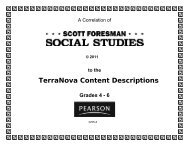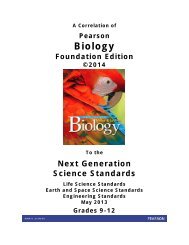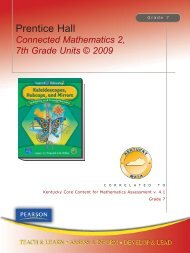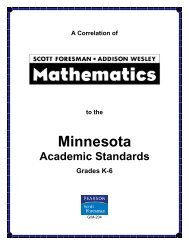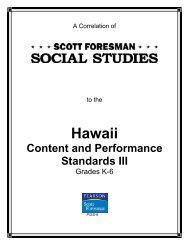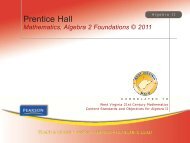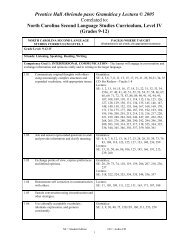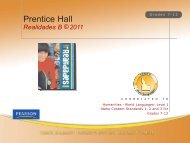Miller & Levine Biology - Pearson
Miller & Levine Biology - Pearson
Miller & Levine Biology - Pearson
Create successful ePaper yourself
Turn your PDF publications into a flip-book with our unique Google optimized e-Paper software.
A Correlation of<strong>Miller</strong> & <strong>Levine</strong> <strong>Biology</strong>, ©2014to the Next Generation Science Standards, May 2013Grades 9-12Science and Engineering PracticesDeveloping and Using ModelsModeling in 9–12 builds on K–8 experiences andprogresses to using, synthesizing, and developing modelsto predict and show relationships among variablesbetween systems and their components in the natural anddesigned worlds.•Develop and use a model based on evidence toillustrate the relationships between systems or betweencomponents of a system. (HS-LS1-2)SE: Q1 and Q2 (p. 219); Q1 and Q2 (p.689); Q3 (p. 867); Q1 (p. 889)•Use a model based on evidence to illustrate therelationships between systems or between components ofa system. (HS-LS1-4),(HS-LS1-5),(HS-LS1-7)SE: Figure 8–7 (p. 233); Figure 8–11 (p.238); Q1 and Q2 (p. 243); Q37 (p. 270);Visual Summary (p. 285); Q1 and Q2 (p.299); Q4 (p. 385)TE: Summative Performance Task (p. 242);Teach for Understanding (p. 254); Check forUnderstanding (p. 259); SummativePerformance Task (p. 266); DifferentiatedInstruction (p. 295)Planning and Carrying Out InvestigationsPlanning and carrying out in 9-12 builds on K-8experiences and progresses to include investigations thatprovide evidence for and test conceptual, mathematical,physical, and empirical models.•Plan and conduct an investigation individually andcollaboratively to produce data to serve as the basis forevidence, and in the design: decide on types, how much,and accuracy of data needed to produce reliablemeasurements and consider limitations on the precision ofthe data (e.g., number of trials, cost, risk, time), andrefine the design accordingly. (HS-LS1-3)SE: Quick Lab (p. 683); Quick Lab (p. 866)LMA: Plant Hormones and Leaves (pp. 147–150); The Effect of Chemicals on Heart Rate(pp. 265–269)Constructing Explanations and Designing SolutionsConstructing explanations and designing solutions in 9–12builds on K–8 experiences and progresses to explanationsand designs that are supported by multiple andindependent student-generated sources of evidenceconsistent with scientific ideas, principles, and theories.•Construct an explanation based on valid and reliableevidence obtained from a variety of sources (includingstudents’ own investigations, models, theories,simulations, peer review) and the assumption thattheories and laws that describe the natural world operatetoday as they did in the past and will continue to do so inthe future. (HS-LS1-1)SE: Q2 (p. 355); Q38 (p. 388)TE: Evaluate Understanding (p. 371)Disciplinary Core IdeasLS1.A: Structure and Function•Systems of specialized cells within organisms helpthem perform the essential functions of life. (HS-LS1-1)SE/TE: Cell Specialization (p. 215);Specialized Tissues in Plants (pp. 664–668);Neurons (p. 897); Bones (pp. 924–925);Muscle Tissue (pp. 928–929); Blood (pp.954–955)•All cells contain genetic information in the form of DNAmolecules. Genes are regions in the DNA that contain theinstructions that code for the formation of proteins, whichcarry out most of the work of cells. (HS-LS1-1) (Note:This Disciplinary Core Idea is also addressed by HS-LS3-1.)SE/TE: Carbon Compounds (pp. 45–49);The Structure of DNA (pp. 344–348); DNAReplication (pp. 350–353); RNA Synthesis(pp. 364–365); The Genetic Code (pp. 366–367); Translation (pp. 368–370)•Multicellular organisms have a hierarchical structuralorganization, in which any one system is made up ofnumerous parts and is itself a component of the nextlevel. (HS-LS1-2)SE/TE: Levels of Organization (pp. 216–217); Seed Plant Structure (p. 664); RootStructure and Growth (pp. 669–670); StemStructure and Function (pp. 674–675); LeafStructure and Function (pp. 680–681);Features of Body Plans (pp. 737–738);Organization of the Human Body (pp. 862–864)•Feedback mechanisms maintain a living system’sinternal conditions within certain limits and mediatebehaviors, allowing it to remain alive and functional evenas external conditions change within some range.Feedback mechanisms can encourage (through positivefeedback) or discourage (negative feedback) what isgoing on inside the living system. (HS-LS1-3)SE/TE: Homeostasis and Cells (pp. 214–217); Gas Exchange and Homeostasis (pp.682–683); Maintaining Homeostasis (p. 732);Homeostasis (pp. 827–830); Homeostasis(pp. 865–867); The Kidneys andHomeostasis (pp. 886–887); IntegumentarySystem Functions (p. 935); Breathing andHomeostasis (p. 967); Blood GlucoseRegulation (p. 984); Control of the EndocrineSystem (pp. 986–987)Crosscutting ConceptsSystems and System Models•Models (e.g., physical, mathematical, computermodels) can be used to simulate systems andinteractions—including energy, matter, and informationflows—within and between systems at different scales.(HS-LS1-2), (HS-LS1-4)SE: Quick Lab (p. 203); Visual Summary (p.206); Quick Lab (p. 275); Visual Summary(p. 285)Energy and Matter•Changes of energy and matter in a system can bedescribed in terms of energy and matter flows into, outof, and within that system. (HS-LS1-5), (HS-LS1-6)SE: Zooming In (p. 237); Zooming In(p. 238); Q4 (p. 243); Chapter Mystery, Q2and Q3 (p. 245)TE: Teach for Understanding (p. 226);Transfer Performance Task (p. 242);Summative Performance Task (p. 266)•Energy cannot be created or destroyed—it only movesbetween one place and another place, between objectsand/or fields, or between systems.(HS-LS1-7)SE: Comparing Photosynthesis andRespiration (p. 253); Q5 (p. 260)TE: Address Misconceptions (p. 255)Structure and Function•Investigating or designing new systems or structuresrequires a detailed examination of the properties ofdifferent materials, the structures of differentcomponents, and connections of components to reveal itsfunction and/or solve a problem. (HS-LS1-1)SE: The Human Genome Project (pp. 406–407); Changing DNA (pp. 423–425);Transgenic Organisms (pp. 426–427);Technology & <strong>Biology</strong> (p. 435)Stability and Change•Feedback (negative or positive) can stabilize ordestabilize a system. (HS-LS1-3)SE: Nutrient Transport (p. 687); Quick Lab(p. 732); Analyzing Data (p. 828); VisualSummary (p. 1018)LMA: Modeling Breathing (pp. 279–282)<strong>Biology</strong>.com: Chapter 28 Data Analysis,Metabolic ActivitySE = Student Edition; TE = Teacher’s Edition; LMA = Lab Manual A 6



